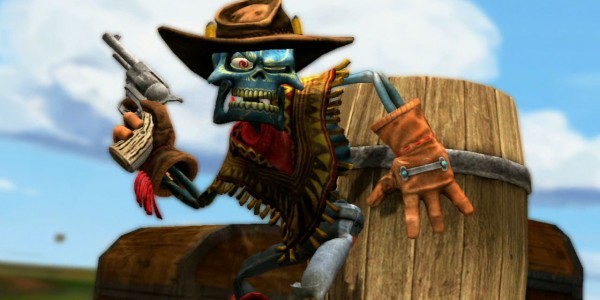[viddler id=1a481828&w=600&h=380]
Rail shooters found Kinect a tenuously appropriate vehicle when Child of Eden hit the psychedelic sweet spot in June 2011. Now, charm-smothered and bristling with the potential of Microsoft’s motion camera peripheral, The Gunstringer wrangles the awkward approximation of controller-free gaming with equally adolescent grace. It revels in referential nods and disgust for the fourth wall, burning sacred cows with gleeful frequency. It’s imperfect and sensitive as Kinect gamers might expect, and it’s relatively short. But it’s a pleasantly unexpected justification for that expensive camera on the T.V. stand.
To set the scene, in earnest:
An undead marionette cowboy hunts down his former posse to exact revenge, shooting, stomping, and slicing through the minions, the miles between them. Armed with a six-shooter, charging across dusty highways dotted by devil-borne tacos, players control the Gunstringer from the first arm raise to the final finger shootout of the ten hour campaign. A grizzly, dramatically baritone narrator fills the audio space between the hum of country guitar riffs as a live-action audience of Twisted Pixel employees watches on in exaggerated horror, surprise, and elation.
And… scene.
The Gunstringer is about breaking boundaries, particularly between the player, the game, and the developers. The controls begin the process, allowing players lateral dominion over the Gunstringer with left hand movements and authority over his revolver with the right. Players can lock up to six targets at a time by waving over them, and then fire with an upward jerk (cue theatrical pointing). Some segments call for jumping or two-axis movement, which the left hand also controls; others require dual-fisted mid-air thrusting, pointing, and waving. The toughest (most rewarding) recurring moieties find the zombie protagonist wielding dual pistols, one for each of the players hands, popping off rounds non-stop. Twice the firepower, twice the concentration, twice the L-shape finger guns.
My distinct apprehension when beginning this game was its ability to interpret my movements effectively; not one-to-one, but with enough consistency that its mechanics could be learned and mastered. In my experience, right hand shots map with near perfect competency. Left hand moves, especially jumps (which depend heavily on timing), perform adequately, usually. Playing the game sitting down, as the game advertises for comfort, is uncomfortably jerky. Co-op play suffers the same fate (in an ample living room).
Standing solo, The Gunstringer is the El Camino of Kinect games – one part luxury, one part utility, all parts shtick. Twisted Pixel’s plucky humor drenches the campaign, from an inflatable wavy arm nemesis to lumberjack-gator love to cowboy-Indian-samurai shootouts to what I think qualifies as the bustiest brothel in gaming. Level design takes on a “Toy Story” aesthetic, crafting trains from Lincoln Logs and cows from milk cans. Each stage employs pop-culture imitations like the renditions of Japanese fortune cats, Duck Hunt, God of War, “The Good, The Bad, and the Ugly”, and “Kill Bill”, all couched with a wink and a nod to their sources, usually by the narrator. The creative kindling fueling The Gunstringer doesn’t depart from Twisted Pixel’s trademark quirkiness, so expect just the best kind of stupid.
Points, stage medals, and a store with gameplay augments (like Ghost Gunstringer) and behind the scenes videos make a requisite, agreeable addition to the campaign. And packaged in with this forty dollar title is the first batch of DLC and Fruit Ninja Kinect, offsetting the main game’s brevity. These offer a modicum of replay value to this Western tale, but it’s the candid, open nature of Twisted Pixel infused in the store, the play mechanics, and the game’s presentation, that emotes a similar player response. The intentionality of the fake audience expression, the artificial landscapes, and exaggerated stereotype enemies tell the gamer, “The referenced material takes itself too seriously, because the wall between consumer and media is paper thin.” It’s bold, stated humorously, and a fitting message in the era of motion controls.
The Gunstringer‘s undead revenge quest does more with its personality than most controller-locked releases can waggle a stick at. It reins in the often frustrating Kinect technology for platforming, rail shooting, and beat-em-ups, wrapping it in a clean, outlandish, and thoughtful ludonarrative approach. Lone rangers can expect a responsive ride through desert, forest, swamp, and hell. And when the sun sets on the Kinect some years from now, when developers have grown too stodgy for whimsy, and games are played in pill form, The Gunstringer will remain an inventive, cheeky Western in a dry spell of compelling content.


















